Improving your Wi-Fi network’s performance is crucial for a seamless online experience.
- Ideal Router Placement: Put your router in a central spot, avoiding thick walls and interference-prone areas.
- Choose the Right Band: Modern routers offer 2.4 GHz for broader coverage and 5 GHz for speed but close proximity; pick accordingly.
- Regular Firmware Updates: Keep your router’s software updated for better performance and security.
- Adjust Channels: If interference disrupts your signal, switch to a less crowded channel in 2.4 GHz or 5 GHz.
- Secure Your Network: Protect your Wi-Fi with a strong, unique password to prevent unwanted access.
- Quality Hardware Matters: Invest in a high-quality router and modem to ensure good performance.
- Manage Device Load: Limit the number of connected devices to prevent network overload.
- Upgrade Internet Plan: Consider a faster ISP plan if your current speed is insufficient.
- Expand Coverage: Use Wi-Fi extenders or mesh systems to eliminate dead zones in your home.
- Optimize Router Settings: Fine-tune router settings for your needs, including bandwidth, QoS, and Beamforming.
- Reduce Interference: Keep electronic devices like microwaves away from your router and choose a clear channel.
- Update Network Drivers: Ensure your device network drivers are up to date to avoid connection issues.
- Use Wired Connections: For stationary devices, use Ethernet cables for a stable and fast connection.
- Monitor Bandwidth: Track data usage to identify and manage bandwidth-hogging devices or apps.
- Restart Routinely: Periodically restart your router to clear caches and improve performance.
Is there anything better?
Yes there is: Wi-Fi 6, also known as 802.11ax, is the latest generation of wireless networking technology. It builds upon the foundation of previous Wi-Fi standards like 802.11ac (Wi-Fi 5) and offers several significant improvements in terms of speed, capacity, and efficiency. Here are some key features and benefits of Wi-Fi 6:
- Higher Speeds: Wi-Fi 6 provides faster data transfer speeds compared to previous Wi-Fi standards. It can deliver peak speeds of up to 9.6 Gbps (gigabits per second), although real-world speeds will vary depending on your devices and network conditions.
- Increased Capacity: One of the most notable advancements of Wi-Fi 6 is its ability to handle more devices simultaneously. It uses technologies like Orthogonal Frequency Division Multiple Access (OFDMA) and Basic Service Set (BSS) Coloring to better manage and allocate bandwidth to multiple devices, reducing congestion in crowded environments.
- Improved Range: Wi-Fi 6 offers better performance at the edge of the network, meaning that devices farther from the router can still enjoy a strong and stable connection.
- Better Performance in Dense Areas: This technology is particularly beneficial in environments with a high concentration of devices, such as airports, stadiums, and crowded urban areas, where previous Wi-Fi standards may have struggled to maintain reliable connections.
- Enhanced Security: Wi-Fi 6 includes stronger security features, such as WPA3 encryption, which provides improved protection against unauthorized access and eavesdropping.
- Improved Battery Life: Target Wake Time (TWT) is a feature of Wi-Fi 6 that allows devices to schedule when they wake up and communicate with the router. This helps reduce power consumption, extending the battery life of mobile devices.
- Backward Compatibility: Wi-Fi 6 is backward compatible with previous Wi-Fi standards, so it can work with older devices that use Wi-Fi 4 (802.11n) or Wi-Fi 5 (802.11ac). However, to fully take advantage of Wi-Fi 6’s capabilities, you need devices that support the standard.
- Efficient Channel Utilization: Wi-Fi 6 uses a technology called Basic Service Set (BSS) Coloring to reduce interference between neighboring Wi-Fi networks operating on the same channel.
To make the most of Wi-Fi 6, you’ll need a compatible router or access point and devices (such as smartphones, laptops, and tablets) that support the standard. As more Wi-Fi 6-enabled devices become available and the technology becomes more widespread, users can expect improved wireless performance and reliability, especially in situations where multiple devices are connected to the network simultaneously.
Aid IT Services specializes in troubleshooting and resolving slow network and Wi-Fi issues, delivering expert solutions for both residential and business settings. We offer free on-site consultations and tailor solutions to your specific needs, ensuring that you experience consistently fast and reliable internet connectivity in the comfort of your home or the efficiency of your business operations.




